| MAKING CUSTOM SHIPPING BOXES |
 |
| While pre-cut cardboard boxes are great - the kind that are shipped to the buyer flat, to be constructed when needed - for some businesses this just isn't the most practical option. Take us, for example. We ship canvases and frames of every size, from tiny 4x5" floater frames to massive 80" wide gallery wrapped canvases. In order to have the right box every time, and not waste time and money on overpadding and securing small items in boxes that are too big, we would need hundreds of different boxes available at all times. That isn't practical or feasible.
If your small or home business is in the same boat, you might consider doing what we do: custom-cut every box to the exact size needed for each individual order. We break it down for you, below.
|
SUMMARY
This article takes a close look at all the steps involved in creating custom boxes to give your products the best possible protection when shipping. Click on a headline to jump to that section of the article.
Common Shipping Terms
|
| THE CARDBOARD
|
 |
|
At KeenART Media, we order large, flat sheets of corrugated cardboard. Specifically, we use C-flute, ECT 32, 84x100 inch cardboard. What does this mean, exactly?
FLUTE refers to the size of the corrugated ridges or flutes within the cardboard. There are many different flute designations, which are categorized by the number of ridges per linear square foot. C-flute is the most common corrugated style for shipping boxes, though if the product is very heavy or breakable, a thicker, double-wall flute such as A or B, or even a double flute like A/B may be a better choice.
Single- and double-wall refers to how many layers make up the cardboard. Single-wall corrugated means a single sheet of ridged cardboard is sandwiched between two "linerboards" - thin, flat cardboard sheets. C-flute is a single-wall type. Double wall has two layers of ridged cardboard, separated by a linerboard, and then sandwiched between two more linerboards.
For more information about different flutes, see the related section in our article on Corrugated Cardboard.
ECT stands for Edge Crush Test. By applying heavy pressure to the short edges of a piece of cardboard, manufacturers determine how much stacking weight a box can withhold. How heavy your product is, how and high it may be stacked while shipping or storing, will dictate what ECT rating you require. ECT 32 means this cardboard can withstand weight of 32 pounds per square inch.
For more information on the tests cardboard undergoes, see the related section in our article on Corrugated Cardboard.
DIMENSIONS required for your own custom boxes will depend on the largest boxes you need to create. If you never make a box larger than 20 x 20 inches, for instance, you do not need to buy 84 x 100 inch sheets. However, it is much easier to cut down a large sheet and use it for multiple boxes than it is to attach additional boxes together if your sheets aren't big enough - this will only hinder stability.
|
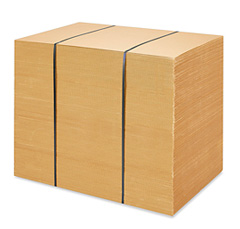
A stack of single-wall corrugated cardboard Pads
|
| PROTECTING YOUR PRODUCT
|
 |
|
There are no hard and fast rules for how to protect your product beyond this: if you're shipping, package it well! You don't want to deal with claims through the delivery company should something befall your product on its way to the customer.
Crumpled newspaper, "peanuts", even large blocks of rigid foam work well to protect your items, though the latter can often result in much larger boxes which equals higher shipping costs. At KeenART Media, we keep interior packing supplies pretty simple.
Bubble wrap is great for keeping the sides of a heavy frame safe, but may not be helpful on the corners - those sharp edges can easily pop the blisters!
Foam wrap is excellent for wrapping breakable items. Everywhere it doubles up, it creates a strong, protective padding that lessens the chance of box punctures reaching your product. We use it on nearly every item we ship. It is also easily reused by the customer the next time they mail something
Styrofoam corners protect the corners of heavy picture frames. When these are in place, its highly unlikely any dings or chips will damage the corners of a frame. They do add more than an inch to each dimension, and only come is certain sizes. A larger corner can be used on a smaller frame, however, simply by inserting a layer or two of cardboard to fill the rest of the space. To order online click here: StyroFoam Corner Protectors
Cardboard corners are simply constructed from waste strips of cardboard. They can be folded as many times as necessary to correct a box that is slightly too large, reinforce the box corners for a heavy item, or to offer extra protection should the parcel be inadvertently dropped on its edge during transport.
|
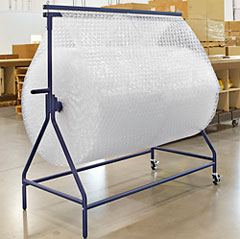
Bubble wrap
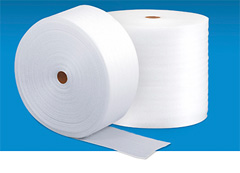
Foam Rolls, 1/16" or 3/32" thickness
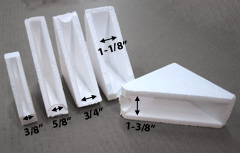
StyroFoam Corner Protectors
|
| DETERMINING BOX DIMENSIONS
|
 |
|
We make and ship our products using TELESCOPING TRAY Boxes. Telescoping Tray boxes have a Lid and base, which are used together to completely package a product. Telescoping Tray can be used for packaging large thin items. The cover is usually the same height as the base.
- To determine the size your box must be, you must first measure your product. Protect it with any additional wrapping or foam corners before you measure. Record the length, width, and height of the product on a piece of scrap paper. Our sample product is a canvas print 16" wide by 20" long by 1" deep.
- When the cardboard is folded up to form sides, it will decrease the inner dimensions of the box by about 1/2 inch, depending on how thick the cardboard is. Taking that into consideration, as well as any additional protection you may choose to pack around the product once it is in the box, increase your product measurements. For this example, I have added 1/2 inch to each side (for a total of one inche on each measurement). (Do not add to the depth measurement unless you are planning to add more protection on top.)
- Although our product depth is 1-1/2 inches, in our shipping department, we do not make boxes any smaller than 2 inches. We will lose two inches on each side from folding up the sides, so this means we add 4 inches to the width and height dimensions. The total dimensions for our flat cardboard sheet is now 21 x 25" (Bottom Part).
- This first sheet of cardboard only creates the bottom and sides of the box, so we must make a lid/top. To do this, simply add 1/2" to each dimension. This will make a second open-top box almost exactly the same size, but with just enough space to fit snugly over the base box.
From this point forward, the smaller box will be called the "base," and the larger box will be called the "lid."
We have developed an easy-to-use calculator that allows you to convert known product dimensions into the perfect box dimensions.
|
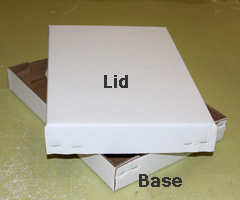
Telescoping Tray Box Style
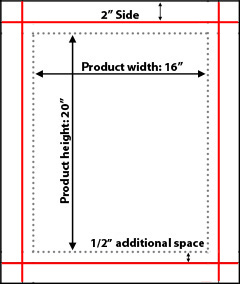
Product size: 16 x 20 x 1.5"
Base Cut: 21 x 25" (this image)
Lid Cut: 21.5 x 25.5"
Folding Lines: 2" deep
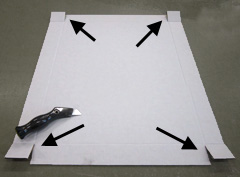
|
| MAKING THE BOX
|
 |
CUTTING THE SHEETS
Now that you know the dimensions of your box, begin by cutting the square or rectangular in the size you require. A ruler, measuring tape, and scissors or utility knife will work for this purpose, though a dedicated cutter with marked gradations will make your job much easier. The cutter pictured at right has been mounted on the wall, and features measurements on the horizontal rest, where the large cardboard sheet will be placed.
Prior to this, we have cut our large 84 x 100" cardboard sheets into sizes that are easier to work with. We still have large sheets available for very big orders, but multiple stacks have been cut into 84" high sheets of 25", 30", 40", 45", and 55" wide. This way, we can easily select the smallest width that suits our current box.
In the case of our example, we can use the 25" width. Placing the cardboard on the cutter, we cut one piece at 26" (the base), and a second piece at 26.5" (the lid). Now these two smaller pieces can be cut along the former width at 22" and 22.5" respectively. We now have two sheets of cardboard, one 1/2" larger than the other on both dimensions.
We sell vertical paper cutters in our online store:
CREATING THE SIDES
To fold the edges of the cardboard sheet to create the sides of the box, we use a handmade folder that was simple to make. Every second stacked board is placed back a specific distance. From the bottom, the indents are measured at 2", 2.5", 3", 4", 5" and 6". The small top-most indent is 1". When the length of cardboard is placed in correct indent and bent up and down, it creases at exactly the dimension required for the box side. For our example, we will insert our box in the 2" slot.
Once all four sides of both cardboard sheets have been creased/folded, you are ready to create the box flaps. This is done by cutting along the crease from the edge up to the crossing fold. Do this four times, using the same two creases on each end of the sheet. Then flip the sheet over.
FINISHING THE BOX
A heavy duty, handheld stapler is the best way to secure the flaps of the box; we find #6 and #8 size staples work well. Fold up the sides and place the short, cut flap along the length of the adjacent side and staple it in place. Depending on the size of the box, you may want to use a number of staples on each flap to ensure stability. Always put the short flap on the inside of the box. If it is on the outside, there is a better chance of it getting ripped away during transport.
Follow these steps for the lid of the box as well, and ensure it fits snugly over the base.
|
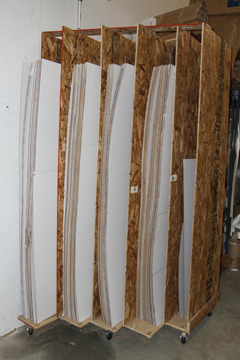
Cardboard storage for different widths
From 30" to 60" wide and 100" height
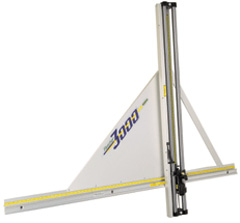
We use Fletcher 3000 Wall-Mounted Multi-Material Cutter
|
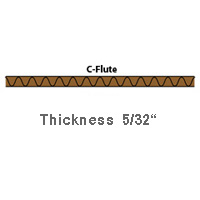
C-Flute 5/32" Tickness
|
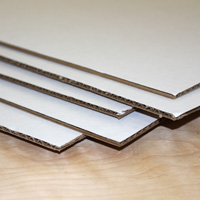
EC32 C Kraft
|
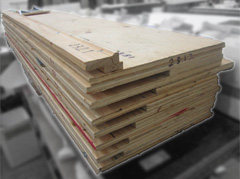
A simple folding machine
2" to 6" deep
| 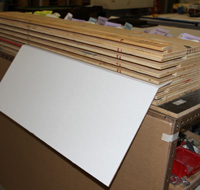
Folding the cardboard
|

Flaps for the sides
|
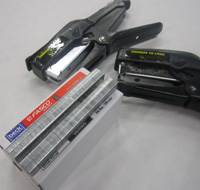
Bostitch P6C-8 & P6C-6 Pliers/Staplers
|
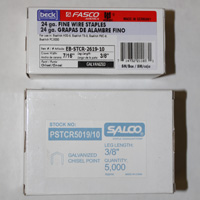
Fasco EB-STCR-2619-10 Crown Width 7/16" - Leg Length 3/8"
Salco PSTCR5019/10 Leg Length 3/8"
|
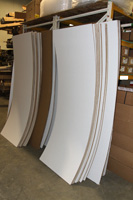
Cardboard Sheets
CS2525 COR.SHEET: 48"x96" EC32 C Kraft
|
|
| SECURING THE PACKAGE
|
 |
|
Packing Tape
An essential tool for securing your package once the product is boxed. Use good quality tape and make sure all corners are closed. The tape does not need to wrap all the way around the package, but four long strips that reach all the way across the top/bottom and around the sides is more secure than one short piece each corner.
Fragile Stickers
Useful if you are shipping breakable items, but do not rely on them in lieu of proper packaging. At the very least, having a fragile sticker on the box may help you if you need to file a claim regarding a package damaged during transport.
Strapping Machines
Not essential, but certainly useful if you ship a lot of heavy or very large boxes. Not only do they work like extremely strong tape, making sure your box stays sealed, but they also provide a handy carrying strap for the delivery person. This can prevent dropping and possibly encourage more careful handling.
|
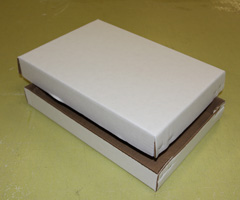
An empty, finished box
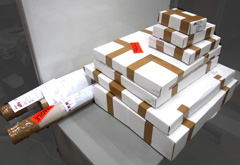
Finished boxes, ready to be shipped
|
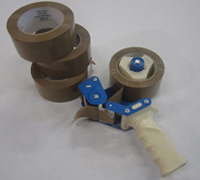
Packing tape and dispenser
| 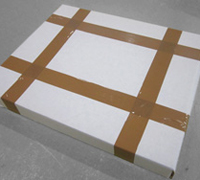
Tape the box securely
| 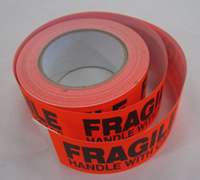
"Fragile" stickers
| 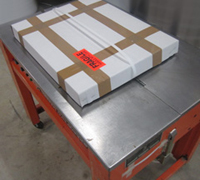
A strapping machine
|
|
| OPTIMIZED CUTTING SOFTWARE
|
 |
|
Cutting Optimization Pro is a time-saving and waste-minimizing software that works for a wide range of industrial materials, such as glass, plexi, plastic, wood, and tubing. This software is used for obtaining optimal cutting layouts for one (1D) and two (2D) dimensional pieces.
If you have numerous custom boxes to create, for which you already know the sizes, optimized cutting software can save you time and money by telling you exactly which cuts to make to get the most out of your large sheet of cardboard. At KeenART Media, we use this software for bulk creation of the most popular box sizes; this keeps waste to a minimum.
Once you have determined the box dimensions (our shipping calculator can help), you simply enter them into the program, along with the total size of your starting sheet. The program will then calculate the arrangement that ensures the least possible waste. For instance, if you need two boxes with the dimensions 4x5" to be cut from a 21x6" sheet, you will waste less by cutting option one than option two (pictured right).
This software allows the user to work in any units they choose, as long as they are the same for both the sizes required (the "demand") and the original sheet (the "repository"). Once the dimensions have been entered, the program divides the cuts into as many repository sheets as are necessary to get the required results.
|
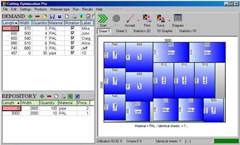
Cutting Optimization Pro

Option One

Option Two
|
| COMMON SHIPPING TERMS
|
 |
|
Air Waybill
This receipt is issued by the airline and confirms their agreement to ship your package. This document may also be called an "air consignment notice."
Actual Weight / Dimensional Weight
Actual weight is the package weight rounded up to the next whole pound.
Dimensional weight reflects package density, which is the amount of the space a package occupies in relation to its actual weight. Dimensional weight may apply to all UPS domestic and international package services.
Billable Weight: Compare the package's actual weight to its dimensional weight. The greater of the two is the billable weight and should be used to calculate the rate. For multiple-package shipments, total the billable weight of all packages in the shipment.
Carrier
Any company or business that provides transportation services to other individuals or businesses. These firms usually own their own transport vehicles, be they trucks, trains, planes, or ships.
COD
Stands for "Collect/Cash On Delivery." This identification on a package implies the shipper did not pay for the shipment and therefore the receiver must do so when they receive the package.
Consignor
The person or company who is shipping the goods, and therefore contacting the carrier. Also called the Shipper.
Consignee
The person or company to whom the carrier delivers the goods they picked up from the consignor.
Dock
Also called a loading dock or loading bay, this is generally a garage door-style opening to which the carrier's truck will back up, making loading the packages easier.
Freight Bill-of-Lading
A BOL, Freight Bill, or BL is the document that outlines the contract between the carrier and the consignor which outlines the expectations for both parties and usually includes a receipt of freight services for the consignor.
Freight Forwarder
A third-party carrier, this corporation arranges with the consignor to have the packages picked up by a certain carrier, and then notifies the carrier when a pick up is required. The forwarder generaly does not own transport vehicles.
Girth
A measurement of size often used by carriers. Girth = (2 x width) + (2 x height/depth), and can be determined by measuring around the short side of the package. A "length and girth" measurement is the sum of the longest side of the package, plus the girth.
LTL (Less-Than-Truckload)
In cases where a carrier's cargo from a single business will not take up all the space in their truck, the cargo is priced individually by piece. Most large carriers such as Fed Ex and UPS operate in this way, unless a very large shipment order is placed.
Over Size
Packages that exceed a carrier's general size or weight guidelines may be subject to additional charges or fees. See more on oversize packages, below.
Pallet / Skid
A small platform generally around four feet square, on which multiple boxes or unboxed supplies can be stacked and secured, and therefore moved as a single piece. Pallets are generally raised from the ground, so a manual or driving lift can be used to maneuver them. Shipping multiple boxes on a pallet helps to ensure no individual box gets lost in transit.
TL / FTL (Truckload, Full Truckload)
Many courier companies work in this way. Rather than applying pricing based on individual boxes, a flat rate is charged for use of the entire truck. Weight fees and charges for fuel to and from the delivery location may be factored into the price. This is generally not required for small businesses, unless a local courier is used.
|
| OVERSIZE SHIPPING
|
 |
|
How do you know if your box will be classified as "oversize" by your chosen shipping company?
An "oversize" item is generally something the company has deemed large enough to require a special transport, or heavy enough that it will be more work - and more danger - for their employees. In addition to extra fees, most companies have a maximum size and weight they will take, after which the shipper must use a courier.
FedEx
At Fed Ex, different rules apply for Ground and Express shipping.
Packages that weigh under 150 lbs but have a length and girth measurement (see terms) of more than 130 inchesare considered oversize. The maximum length and girth Fex Ex will ship is 165 inches. In addition to the regular charges, a fee of about $60 is added to oversize boxes. If Fed Ex Home Delivery is used, the maximum weight is 70 lbs. Packages being shipped express must also be less than 108 inches in length alone.
However, exceptions may apply to packages under the weight limit but over the dimension limits; this is determined on a case by case basis.
UPS
Like Fed Ex, UPS determines sizes based on length and girth. While they cite the same dimensional and weight limits as Fed Ex, they may accept larger or heavier items for an additional charge. Their oversize determinations are made on a case by case basis and special pricing does apply. The company also requires special yellow stickers to be placed on boxes that exceed 70 lbs.
|
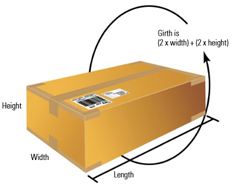
Length + Girth
|
|
Once your product is safely packaged and securely sealed, it is ready to be shipped. Shipping is not a gentle process, so any precautions you can take before the boxes leave your facility are certain to result in fewer damages - and therefore fewer customer complaints.
For more information on corrugated cardboard, including its history and the various box styles available, take a look at our indepth Corrugated Cardboard article.
If you have any questions about our shipping methods, products, or services, please do not hesitate to contact us. Our knowledgeable staff are always happy to answer your enquiries and provide suggestions or advice.
|
|
© 2002-2024 - KeenART Media Ltd.
|
|
| |
|

